Key takeaways:
- Community housing development should prioritize the voices and needs of residents through empathetic engagement and user feedback.
- User-centered design enhances community quality of life by fostering connections and addressing diverse needs through collaborative workshops and inclusive strategies.
- Success stories illustrate the impact of collaboration, such as creating communal gardens and addressing housing shortages through community-led initiatives.
- Key lessons learned include the importance of empathy, interdisciplinary collaboration, and the necessity of iterating designs based on user feedback for meaningful solutions.
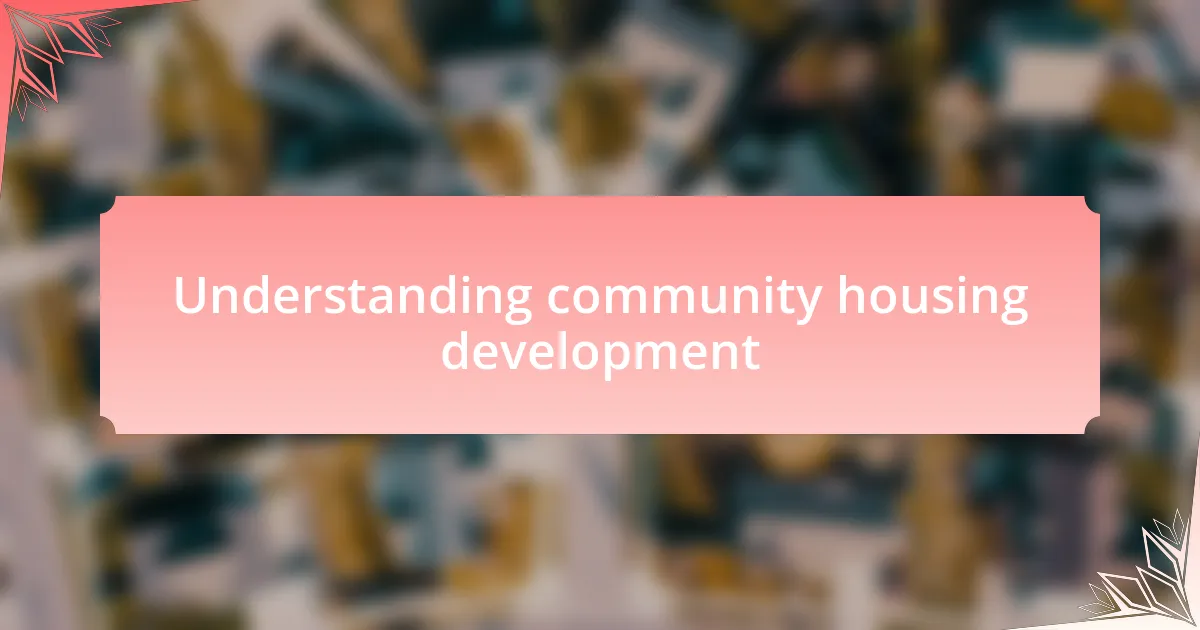
Understanding community housing development
Community housing development is more than just constructing buildings; it’s about fostering a sense of belonging among residents. I recall visiting a newly built community center where families gathered, sharing meals and stories, creating connections that would last for generations. How can we ensure that such spaces truly reflect the needs of the people they serve?
At its core, community housing development must prioritize the voices of the residents. I remember a project where we held listening sessions, allowing future tenants to express their desires and concerns. Their feedback led to design adjustments that increased accessibility and created gathering areas that felt welcoming rather than institutional. Isn’t it fascinating how a few conversations can reshape a project and enhance community spirit?
Good design should be driven by empathy and understanding of the community’s unique culture and challenges. For instance, in a past project, we noticed the need for green spaces that encouraged outdoor activities and social interaction. By incorporating gardens and play areas, we not only beautified the environment but also nurtured healthier lifestyles. How can we continue to make such thoughtful changes that resonate deeply with the residents?

Importance of user-centered design
User-centered design is crucial in community housing development because it directly impacts residents’ quality of life. I recall a project where a simple redesign of the entrance based on resident feedback transformed a cold, uninviting space into a warm and welcoming one. This change fostered connectivity among neighbors; doesn’t it show how thoughtful design choices can influence day-to-day interactions?
Prioritizing user needs creates an environment that truly serves the community. During another initiative, I facilitated workshops where residents shared what amenities they wished to see. It was enlightening to see how their priorities—like a community garden or a dedicated space for children—were often overlooked by the developers. How often do we forget that the best insights come from those who will actually use the spaces we create?
The essence of user-centered design lies in its ability to bridge gaps between developers and the community. I’ve seen firsthand how incorporating residents’ ideas can lead to functional layouts and vibrant communal areas. It’s not just about aesthetics; it’s about building spaces that reflect real lives and real needs. Isn’t that the hallmark of effective design?
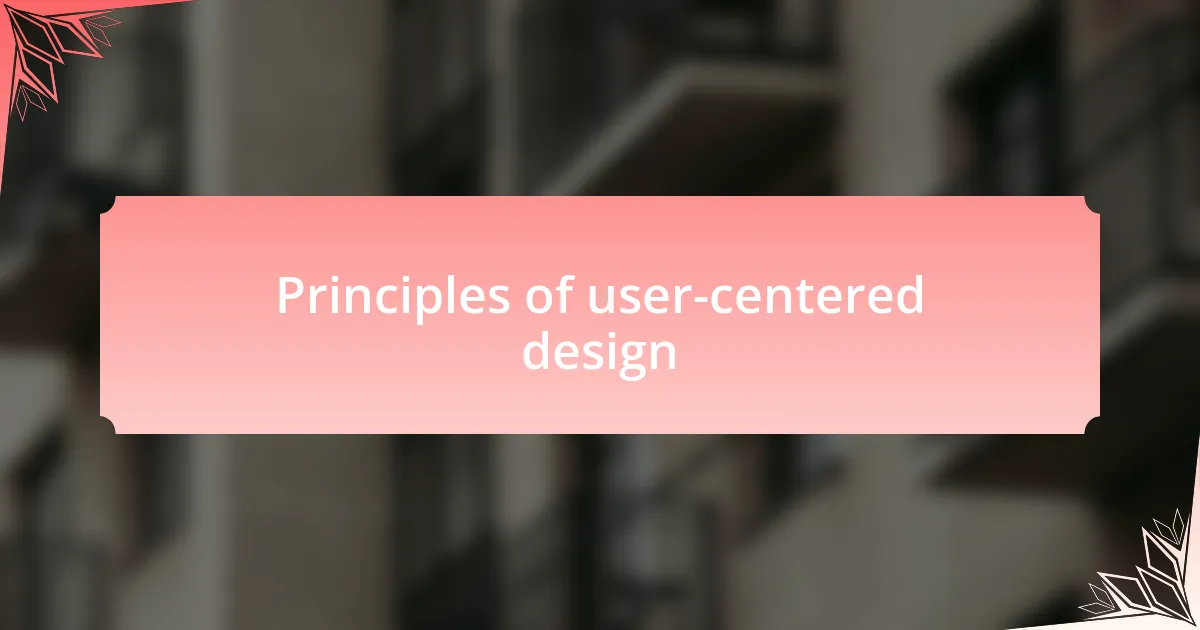
Principles of user-centered design
User-centered design is anchored in several core principles that guide its effectiveness. Firstly, it revolves around understanding users’ needs and behaviors through research and engagement. I remember attending a community meeting where families expressed their need for safe play areas, which ultimately shaped our design decisions. Isn’t it fascinating how a simple gathering can uncover invaluable insights about what truly matters to people?
Another key principle is iterative design, which emphasizes the importance of prototyping and testing. In my experience, seeing a mock-up of a community space and receiving immediate feedback from residents has proven immensely beneficial. It’s almost like painting a portrait together; the more we collaborate, the more accurately we can capture what the community envisions.
Lastly, inclusivity stands at the heart of user-centered design. I was once part of a project that involved seniors who shared unique accessibility challenges. Incorporating their perspectives not only improved functionality but also made them feel heard and valued. How can we claim to create spaces for everyone if we overlook the voices of those who have different needs? It’s a question that continually shapes my approach to design.
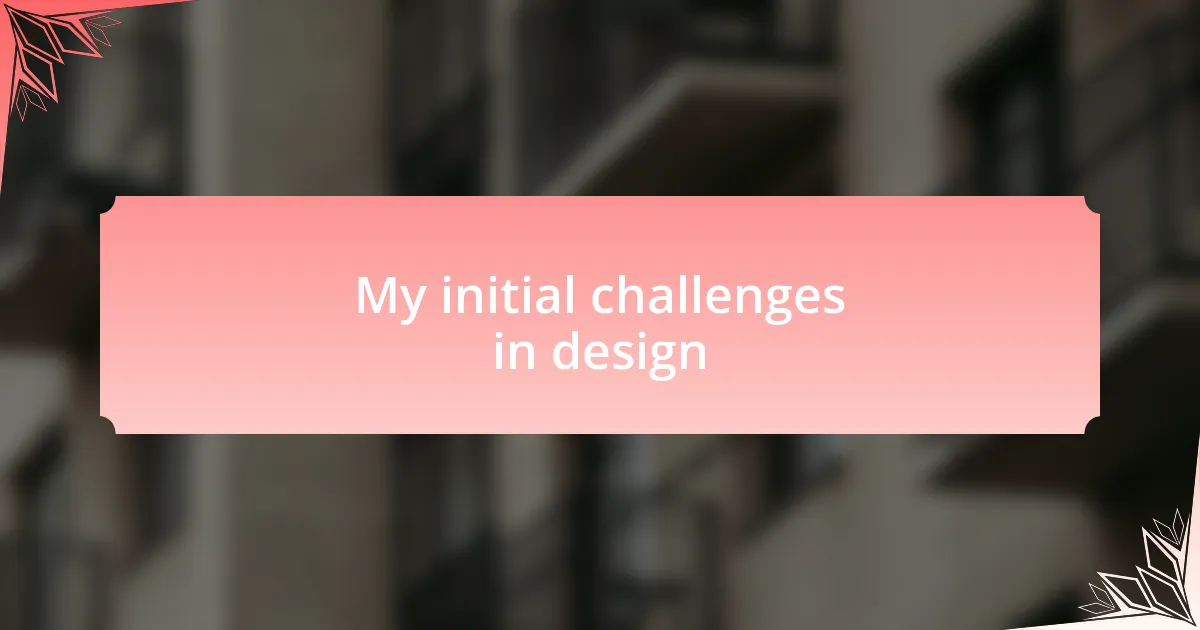
My initial challenges in design
One of my initial challenges in design involved grappling with conflicting perspectives from various community members. I recall a heated discussion where parents prioritized outdoor redesigns while seniors advocated for indoor accessibility. It was a daunting moment, prompting me to wonder: how can we find common ground that not only satisfies diverse needs but also fosters a sense of unity within the community?
Navigating these contrasting opinions sometimes felt like trying to solve a puzzle without all the pieces. I often found myself questioning whether I was truly equipped to balance practicality with idealism. There were times when I doubted my ability to synthesize feedback effectively, leaving me anxious about delivering a design that would resonate with all stakeholders.
Additionally, the lack of clear communication channels created real obstacles. I vividly remember hosting a workshop where many participants felt hesitant to voice their concerns. Their silence was disheartening, and I had to ask myself: how could I create a safe space for everyone to express their thoughts? This challenge not only refined my approach but also urged me to develop more engaging ways to facilitate conversations and encourage participation in the design process.
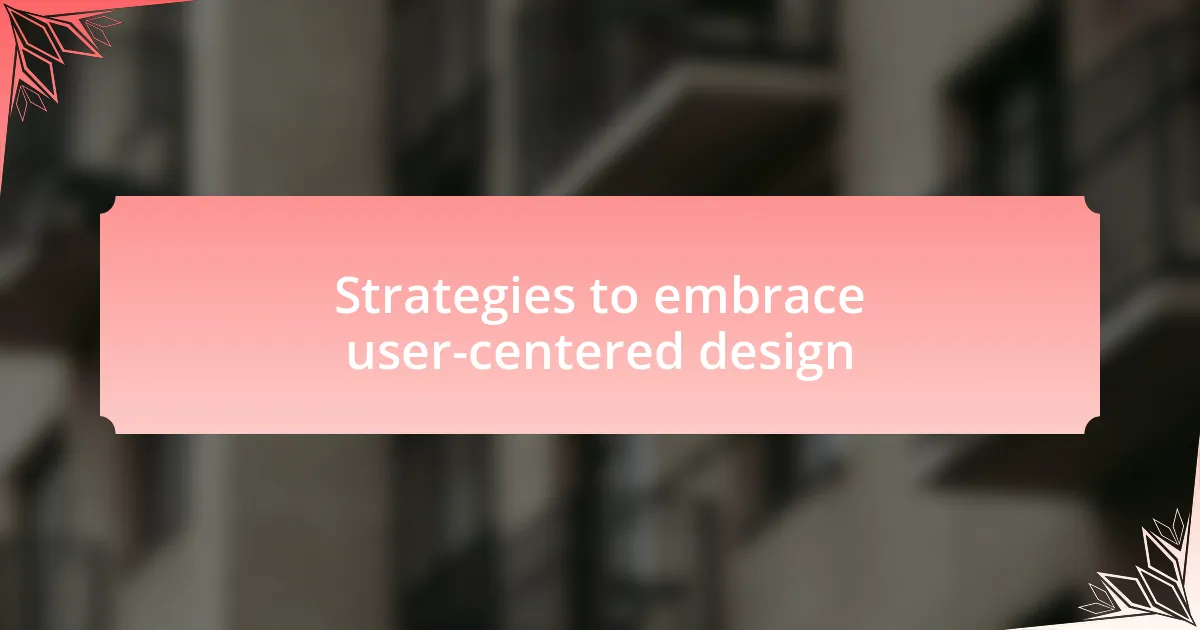
Strategies to embrace user-centered design
To embrace user-centered design, one effective strategy I’ve found is conducting empathetic user interviews. I remember sitting down with a resident whose family had long struggled with housing accessibility. As we talked, I was struck by how their stories illuminated the real-life implications of design choices. This connection made me realize that understanding users deeply is essential; it transforms abstract feedback into tangible insights that can guide every design decision.
Another approach has been to create collaborative workshops that emphasize co-creation. I once led a session where community members sketched their visions for shared spaces. The energy in the room was palpable as ideas flowed freely and everyone felt invested in the outcome. This experience taught me that empowering users to become co-designers not only enriches the process but also cultivates a sense of ownership and pride in the final results.
Lastly, I’ve found that incorporating feedback loops can greatly enhance the design process. After presenting initial concepts, I implemented a series of surveys and feedback sessions. I was surprised at how many valuable suggestions surfaced, revealing user needs I hadn’t considered. This iterative process not only refined my designs but also reinforced the idea that every voice matters, making users feel valued and heard in the journey of design.
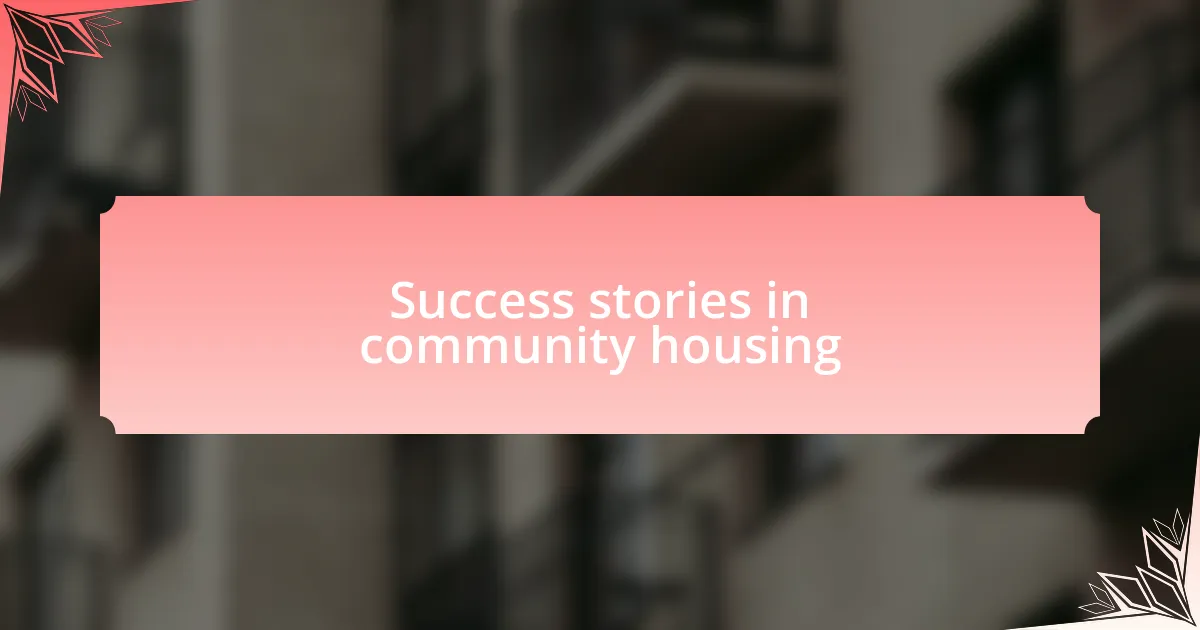
Success stories in community housing
Community housing success stories often highlight the profound impact of collaboration. One project I recall involved a multi-generational community where residents banded together to design a communal garden. Seeing their enthusiasm transformed an empty lot into a vibrant space filled with flowers and fresh vegetables. It was heartwarming to witness how this simple initiative fostered connections among neighbors and cultivated a strong sense of belonging.
Another inspiring tale comes from a small town that faced housing shortages. A group of determined advocates organized a series of design charrettes, bringing locals, architects, and planners together to brainstorm innovative solutions. The outcome was nothing short of remarkable: a mixed-use development that not only provided affordable homes but also revitalized the local economy. I couldn’t help but wonder, how often do we overlook the potential within our own communities to effect change?
Lastly, I learned from a program aimed at supporting homeless individuals. They employed a user-centered design approach by inviting those affected to share their stories and needs. One participant’s narrative led to the creation of mobile support units that offered essential services directly in their neighborhoods. This success demonstrated to me how active listening can spark impactful solutions. Isn’t it incredible how embracing the voices of those directly affected can lead to such meaningful change?

Lessons learned from my journey
As I reflect on my journey, one significant lesson stands out: the importance of empathy in design. There was a time I rushed through a project, thinking I understood user needs without truly listening. After receiving feedback that highlighted the gaps in my approach, I realized that true understanding comes from engaging directly with those we serve. Why do we sometimes overlook this fundamental aspect? I learned that listening isn’t just a step in the process—it’s the foundation for meaningful design.
Another pivotal realization was the value of collaboration across disciplines. I remember working alongside engineers, social workers, and community organizers on a project aimed at offering transitional housing. Each discipline brought unique perspectives and expertise that enriched our approach, leading to innovative solutions I hadn’t considered before. This taught me that diversity in thought leads to greater creativity; by embracing different viewpoints, we can create designs that resonate more deeply with the community. Who knew that a small group of passionate individuals could come together to form such a powerful force for change?
Finally, I recognized the necessity of iterating based on user feedback. Early in my journey, I was hesitant to make revisions, worried that altering the original design would mean failure. However, I eventually saw how embracing feedback not only improved the outcome but also instilled trust within the community. This shift in mindset—from fear of change to openness—was transformative. Isn’t it remarkable how flexibility can lead to stronger connections and better solutions?